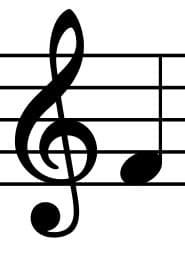Myths about teaching can hold you back
- Year 9
Developing a serialist composition
I can develop a serialist composition by using typical techniques including retrograding.
- Year 9
Developing a serialist composition
I can develop a serialist composition by using typical techniques including retrograding.
These resources were made for remote use during the pandemic, not classroom teaching.
Switch to our new teaching resources now - designed by teachers and leading subject experts, and tested in classrooms.
Lesson details
Key learning points
- Serialist composers use tone rows in many different ways.
- This includes varying the timbre, instrument, rhythm, dynamics, octave and articulation.
- As long as the order of the pitches doesn’t change, this is considered ‘within the rules’ of serialism.
- Another method is to create and use a retrograde of the tone row.
- This is when the order of pitches is carefully reversed, creating a ‘mirror image’ of the tone row.
Keywords
Serialism - an atonal composition method based on a specific order of pitches (a tone row)
Tone row - a specific order of the 12 notes of the chromatic scale, forming the basis of a piece of serialism
Retrograde - when a set of notes (like a tone row) is reversed
Common misconception
Retrograding breaks the rules of serialism because it changes the order of the notes.
Serialist composers don't consider retrograding breaking the rules. It does change the order, but the new order is still closely linked to the original tone row (by being reversed). It is therefore an acceptable and musically interesting technique.
To help you plan your year 9 music lesson on: Developing a serialist composition, download all teaching resources for free and adapt to suit your pupils' needs...
To help you plan your year 9 music lesson on: Developing a serialist composition, download all teaching resources for free and adapt to suit your pupils' needs.
The starter quiz will activate and check your pupils' prior knowledge, with versions available both with and without answers in PDF format.
We use learning cycles to break down learning into key concepts or ideas linked to the learning outcome. Each learning cycle features explanations with checks for understanding and practice tasks with feedback. All of this is found in our slide decks, ready for you to download and edit. The practice tasks are also available as printable worksheets and some lessons have additional materials with extra material you might need for teaching the lesson.
The assessment exit quiz will test your pupils' understanding of the key learning points.
Our video is a tool for planning, showing how other teachers might teach the lesson, offering helpful tips, modelled explanations and inspiration for your own delivery in the classroom. Plus, you can set it as homework or revision for pupils and keep their learning on track by sharing an online pupil version of this lesson.
Explore more key stage 3 music lessons from the Approaches to contemporary composition unit, dive into the full secondary music curriculum, or learn more about lesson planning.
File needed for this lesson
- Serialism template 2.16 KB (MXL)
Download this file to use in the lesson.

Equipment
Notation software or DAW
Licence
Prior knowledge starter quiz
6 Questions
Q1.The scale has 12 notes.
Q2.If music has no key or tonic note, it is described as what?
Q3.Each piece of serialism is based on a sequence of notes called a tone
Q4.How many notes are in a tone row?
Q5.What is wrong with this tone row? (Select two answers)

Q6.What note is this?




